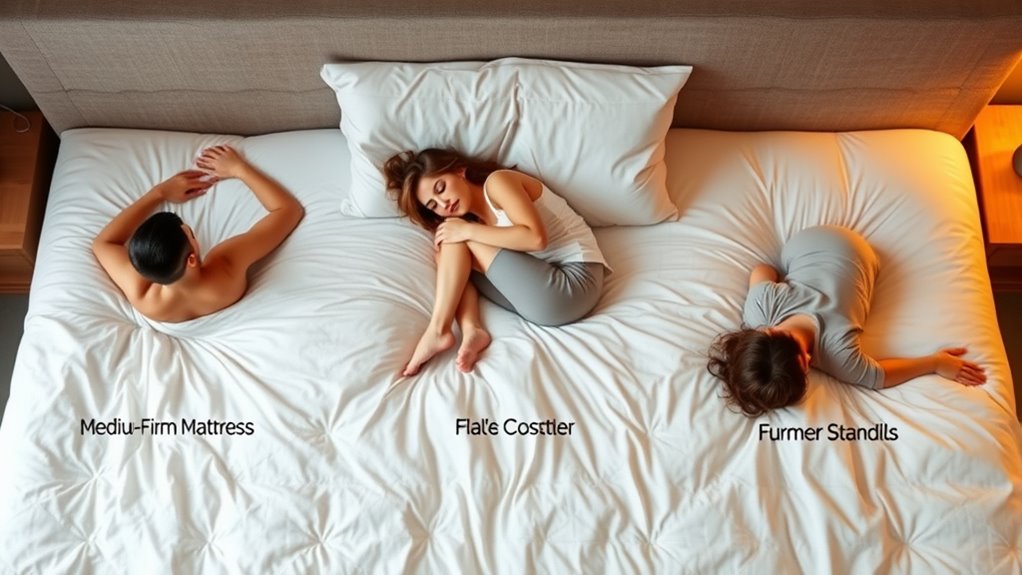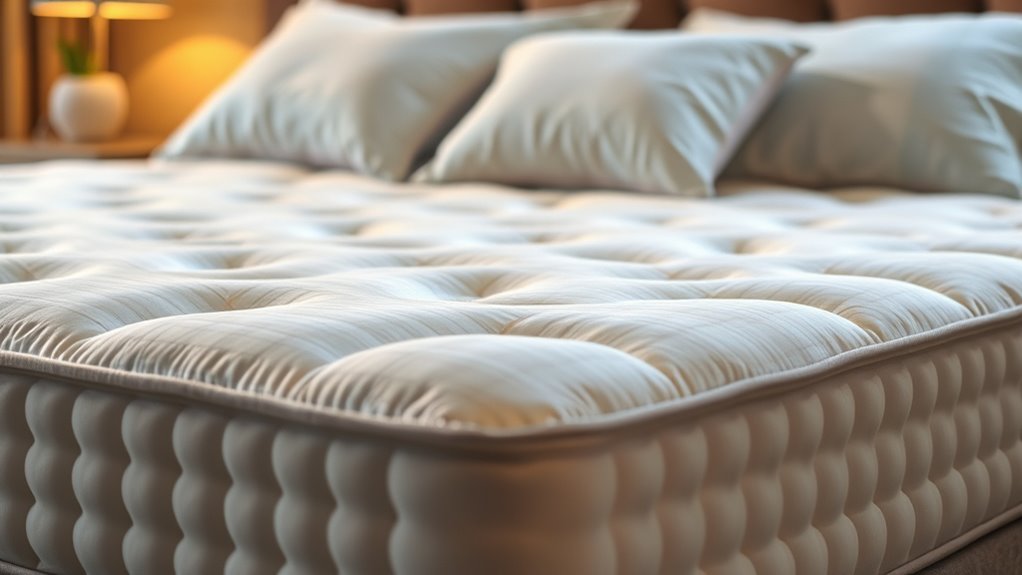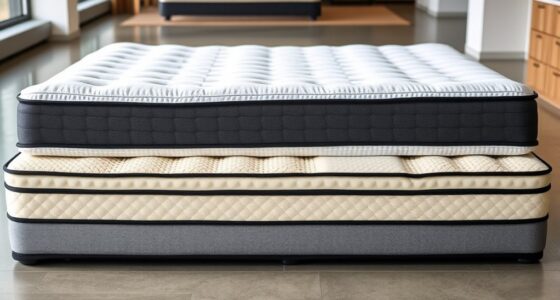To pick the right mattress for your sleep position, consider how each style affects support needs. Back sleepers need a medium-firm mattress to maintain spinal alignment, while side sleepers benefit from softer mattresses that contour to your curves and reduce pressure points. Stomach sleepers require firmer support to prevent hips from sinking and keep your spine neutral. Understanding your sleep position helps you select a mattress that minimizes discomfort, ensuring you wake up refreshed and ready to go.
Key Takeaways
- Match your sleep position with the appropriate mattress firmness: medium-firm for back sleepers, softer for side sleepers, and firmer for stomach sleepers.
- Prioritize support that maintains proper spinal alignment to prevent aches and promote comfortable sleep.
- Choose contouring materials like memory foam for side sleepers to evenly distribute pressure points.
- Opt for firmer support if you sleep on your stomach to keep hips elevated and reduce spinal twisting.
- Consider your sleep position when selecting mattress support to ensure pressure relief and proper body alignment.

Have you ever wondered why some mattresses feel perfect while others cause discomfort? It all comes down to how well the mattress supports your body, especially your pressure points and spinal alignment. When you sleep, your body naturally seeks a position that minimizes strain, but if your mattress doesn’t support that position properly, you wake up feeling stiff or sore. That’s why choosing the right mattress based on your sleep position is vital for a restful night and waking up refreshed.
If you sleep on your back, you need a mattress that offers balanced support. You want enough firmness to keep your spine aligned without creating pressure points that cause discomfort in your shoulders or hips. A medium-firm mattress often works best here because it supports the natural curve of your spine while cushioning your pressure points. This alignment helps prevent back pain and reduces the chances of waking up with aches and pains. When your spine stays in a neutral position, you avoid unnecessary strain, and your muscles can relax fully during sleep. Additionally, knowing the proper support levels for your mattress can significantly impact your sleep quality.
For side sleepers, pressure points become a bigger concern. Your shoulders and hips bear much of your body weight, which can lead to discomfort if these areas aren’t adequately supported. A softer, more contouring mattress can help here by conforming to your body’s curves, dispersing pressure evenly, and preventing those painful pinches or numbness. Memory foam or hybrid mattresses with a softer feel often work well for side sleepers because they cushion your joints and keep your spine aligned, even in your curled-up position. The goal is to avoid sinking too deeply into the mattress, which can misalign your spine and cause soreness in the morning.
Stomach sleepers face a different challenge. They typically need a firmer mattress to prevent their hips from sinking too far, which can twist their spine and create pressure points in their abdomen and neck. A firm mattress helps keep your hips elevated, maintaining proper spinal alignment. If your mattress is too soft, you’ll likely wake up with neck or back pain due to misalignment. It’s vital to find a balance where your stomach, chest, and pelvis are supported without feeling like you’re lying on a hard surface. This support reduces pressure points and helps maintain a healthy, neutral spine position.
Ultimately, understanding your sleep position guides you toward a mattress that supports proper spinal alignment and alleviates pressure points. Whether you’re on your back, side, or stomach, selecting a mattress tailored to your sleep style ensures better rest, fewer aches, and a more energized morning.
Frequently Asked Questions
Can a Mattress Type Change Over Time With Use?
Over time, your mattress can definitely change due to material wear and reduced durability. As you use it, the materials break down, leading to sagging or loss of support. This can affect your sleep quality and comfort. Regularly inspecting your mattress helps you notice signs of wear early. Replacing it when needed guarantees you maintain proper support and comfort, preventing potential sleep issues caused by a worn-out mattress.
How Often Should I Replace My Mattress for Optimal Sleep?
You should replace your mattress every 7 to 10 years to maintain ideal sleep quality, considering its lifespan and your comfort needs. Over time, wear and sagging can affect support and alignment, leading to discomfort. Paying attention to signs like persistent aches or visible damage helps you stick to a good replacement cycle. Regularly evaluating your mattress ensures you get restful sleep and avoid health issues associated with an aging mattress.
Do Sleep Position Preferences Vary With Age or Health Conditions?
Your sleep position preferences can change with age and health conditions. Age-related sleep changes, like reduced mobility or joint pain, might make you favor side or back sleeping for comfort. Health condition impacts, such as arthritis or sleep apnea, can also influence your choice. Being mindful of these factors helps you select a mattress that supports your evolving needs, ensuring better sleep quality as you age or manage health issues.
Are There Specific Mattress Features for Side Sleepers With Shoulder Pain?
You might think a mattress with firm support is the answer, but for shoulder pain, it’s actually about softness where it counts. Look for a mattress with a plush top layer that relieves shoulder pressure. Foam density matters—higher density foam offers better support and durability, cushioning your shoulder without causing strain. So, ironically, a softer surface with the right foam density can turn your nightly agony into sweet relief.
How Do Mattress Materials Impact Temperature Regulation During Sleep?
You might notice that mattress materials like memory foam can trap heat, making you feel warmer during sleep. However, gel-infused memory foam helps regulate temperature by dissipating heat and improving airflow. Choosing a mattress with these features can keep you cooler and more comfortable throughout the night. So, if temperature regulation matters to you, look for gel-infused memory foam options to enhance your sleep experience.
Conclusion
As you settle into your perfect mattress, imagine sinking into a cloud that cradles every curve of your body. Whether you’re a side sleeper needing gentle pressure relief or a stomach sleeper craving firm support, choosing the right mattress transforms your nights into a peaceful retreat. When you find that ideal fit, each morning feels like waking up refreshed, ready to face the day with energy. Your perfect sleep sanctuary is just a mattress away—embrace it.









